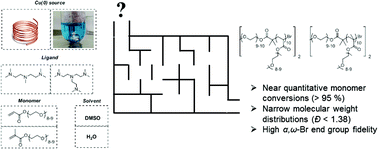The effect of ligand, solvent and Cu(0) source on the efficient polymerization of polyether acrylates and methacrylates in aqueous and organic media†
Abstract
The synthesis of well-defined telechelic polyacrylates and polymethacrylates in organic and aqueous media via Cu(0)-mediated reversible-deactivation radical polymerization is thoroughly investigated. Poly(ethylene glycol) methyl ether acrylate (PEGA480) and poly(ethylene glycol) methyl ether methacrylate (PEGMA475) are used as exemplar monomers to determine the optimum polymerization conditions for the rapid, controlled and quantitative production of both homopolymers and block copolymers. The effect of the copper source (i.e. Cu(0)-wire or Cu(0) particles), the ligand (e.g. Me6-TREN or PMDETA) and the solvent (e.g. H2O or DMSO) on the polymerization of acrylates and methacrylates has been evaluated. Kinetic experiments are performed for all polymerizations to assess the “living” behaviour of each system and method employed. In addition, in situ chain extension with another aliquot of monomer at quantitative or near quantitative conversions have been conducted as an indirect evaluation of the α,ω-Br end-groups functionality of the obtained telechelic materials. The in situ disproportionation of [CuI(L)Br] in both water and DMSO to yield Cu(0) and [CuII(L)Br]Br prior to addition of monomer and initiator and Cu(0)-wire experiments in both solvents dictate the desired polymerization protocol to use, depending on the monomer employed and highlight the weaknesses and potential of each system. Under carefully optimized conditions, narrowly distributed polyacrylates and polymethacrylates homopolymers can be obtained in a quantitative manner (>98% conversion) within 30 min of polymerization with very high end-group fidelity, exemplified by in situ chain extensions; hence highlighting the importance of the appropriate combination of the monomer with a compatible ligand, copper source, solvent and polymerization technique. For instance, well-defined polymethacrylate based block copolymers can be attained in water within 90 min with high conversion (>95% for each block) and relatively low dispersity values (Đ = 1.38).


 Please wait while we load your content...
Please wait while we load your content...